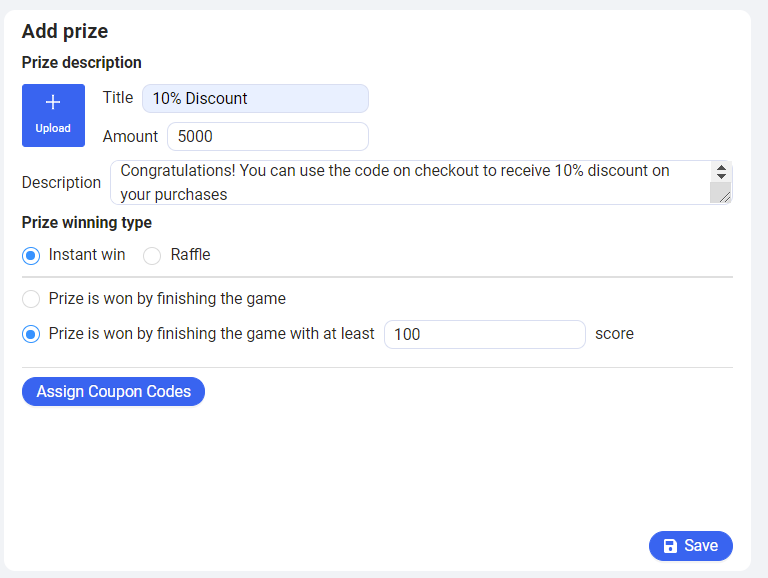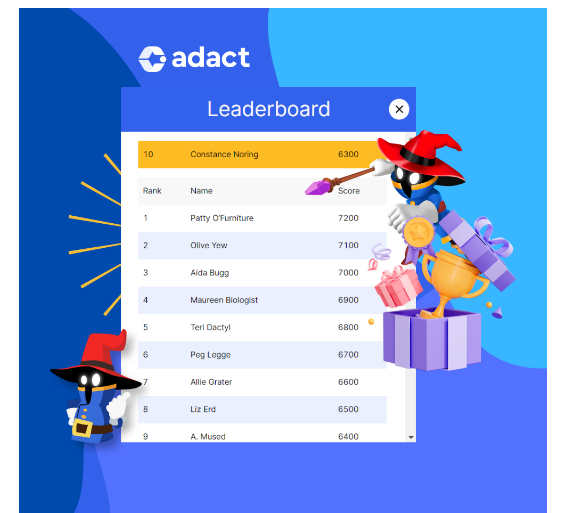Image source: Freepik
You might think that applying gamification in retail requires hiring a team of experienced developers and paying them a ton of money. You couldn’t be more wrong.
Picture this:
You go to a website and log in. Next, you select a campaign type and, using templates, adjust it to match your brand and style. Then you set up prizes, create a leaderboard and publish your campaign. And that’s all! You’ve created a gamification experience for your customers!
Too good to be true? In this article, we will explain how it is entirely possible. Moreover, to inspire you, we will provide four real-life gamification examples that were a great success. Let’s dive in.
What is gamification in retail?
Gamification in retail refers to using game-like elements, mechanics and design in non-game settings to engage customers and create an enjoyable shopping experience. It involves incorporating elements of fun, competition, rewards and challenges into the retail environment.
For example, you can launch quizzes for customized product recommendations or add gamification elements to your loyalty programs.
Why use gamification in retail?
Using gamified elements in the retail industry can have several benefits. Here’s a few:
- Engagement and experience: Gamification aims to increase customer engagement and create positive experiences with the store.
- Improving brand loyalty: Offering rewards, discounts, promotions or other prizes to customers who participate in games or activities is an excellent way of increasing brand loyalty.
- Attracting and retaining customers: Gamification can attract new customers and retain existing ones by making the shopping experience more interactive and fun.
- Increasing sales: Incorporating gaming aspects into retail businesses can increase customer acquisitions and drive revenue.
All in all, ecommerce gamification can make online shopping more fun, which increases customer loyalty and boosts sales at the same time.
Gamification in retail with Adact: 4 success stories
To prove that gamification in sales is one of the best marketing strategies possible, we have four inspiring stories:
Ādažu

Ādažu, a Latvian chip brand, wanted to return their historical products to the stores. They created a limited edition of old chip flavors and used gamification strategies for promotion.
Their goal was to increase positive and nostalgic associations with the brand and win the local market, becoming the most popular chip brand. To do so, they decided to use a Tinder-like game called “Swipe,” where customers like or dislike an item shown to them.
Customers got excited about the campaign even before it was published. POS materials that were available in stores a couple of days before launching the game attracted massive attention.
On the first day of the campaign, the game got a whopping 3,836 votes. The same trend continued for each campaign week, and Ādažu gathered over 19,000 leads weekly.
Customers loved that they could vote so easily and instantly see the general voting results after the game finished. By giving customers a chance to express their voices in a fun and attractive way, Ādažu significantly boosted customer engagement.
Kaubamaja

Each autumn Kaubamaja, a large department store in Estonia, organizes a flash sale named “Shopping Race.” This time they decided to use a gamification campaign to promote it.
Their choice was a Drop Game where customers collected falling objects representing items on sale. Each item they collected earned them points.
The brand managed to get the attention of its target audience with prizes like discounts on popular items and gift cards. It helped to generate excitement around the store and got people talking about the action.
On the first day the game launched, it engaged approximately 10,000 players. 99% of them completed the game, and the engagement time with Kaubamaja’s content reached 150 seconds per person. It is unbelievably higher than the average engagement time with social media ads.
As a result, during the sale, Kaubamaja experienced a significant boost in foot traffic and sales.
Eggo

Brands use different gamification techniques to get customers engaged, and they have different aims. For example, Eggo, Estonia’s egg producer, created a campaign to engage with its customers for the longest time possible.
They launched an innovative marketing campaign called “Eggo World,” a type of well-known Candy Crush game where players matched eggs instead of candies. This digital campaign aimed at increasing brand awareness to change people’s purchase behavior during Easter and make them choose Eggo eggs.
Eggo created the game in such a way as to encourage people to return and play it several times. Here are the results:
- Over three weeks, 4,500 people played the game more than 190,000 times.
- The most active player took part in the game over 4,900 times, which means the person engaged with the Eggo brand for over 80 hours.
- An average player participated in the game 38 times. Since the game’s length was 60 seconds, it meant 38 minutes of brand exposure.
The sales numbers after the Easter season showed that this holiday campaign was a great success, and people chose Eggo eggs for their celebrations.
See also: Easter marketing ideas
Tallink

AS Tallink Grupp is a prominent company that offers passenger and cargo transportation services in the northern area of the Baltic Sea region. The brand used gamification tactics to increase customer engagement and boost brand recognition in the younger audience.
For this purpose, they made a Wheel of Fortune with 5,251 coupons as rewards. Each user could try their luck only once a day.
The campaign was live for one week, and people played the game 5,315 times with a click-through rate of 98.81%. As a result, Tallink collected 3,238 unique leads.
Gamification in retail: How to get in on the action
So how do you incorporate gamification strategies into your retail business? Here’s our step-by-step guide:
Choose a gamification platform
If you want to improve customer experience and increase user engagement by offering gamified experiences, the first step is to choose a gamification platform like Adact.

Adact software allows users to create fully customizable interactive experiences for gamification marketing campaigns without writing a single line of code.
You can use the software to create raffles, public competitions or employee engagement games to achieve record-breaking results.
Adact helps to bring results with gamification marketing, such as:
- 95% campaign completion
- 6+ days of retention
- 5x higher coupon redemption
- 20+ engagements per participant
To use the platform, you only have to sign up and follow these steps:
Choose a campaign type
You know your target audience best, so choose a campaign type that will encourage customers to participate in the game and help you build brand awareness. Here are some of the campaigns you can launch with Adact:
- Jeopardy
- Gamified survey
- Trivia game
- Puzzle game
- Wordle game
- Personality quiz
- Scratch card online
- Guess who game
Customize your game
To increase the chances of engaging users with your game, you can customize it in multiple ways:
- Change the background color and the background of choices and topics
- Set your own branded image as a background
- Customize the design of the grid box, letter colors and fonts
- Change the feedback color if you want
Set up prizes

An essential part of creating gamification experiences is rewarding customers for their time and effort. It’s a natural human impulse to expect rewards, so don’t forget to choose prizes to ensure customers engage with your campaign. Here are a few ideas for prizes you can offer:
- A discount code to your online store
- Loyalty points
- Gift cards
- Early access privilege to sales
- Invitation to an in-store experience like product launch parties or DYI workshop
Make sure to choose a prize that will keep customers coming back for a chance of winning.
Create a leaderboard

The next step is creating a leaderboard where the users can see all the game participants and the scores. A leaderboard is another motivation for users to take part in the game and compete.
- Go to the registration form and add the field “Leaderboard name.”
- Add a new element named “Leaderboard” on the end screen of your campaign. This action will create space to display scoreboard rankings.
- Choose images, background colors, fonts and labels to customize your leaderboard.
- Select the method of displaying the rankings: by score, time or other metrics.
Publish your campaign
Now it’s time to make your campaign available to online visitors. You have two possibilities:
- Publish the campaign through your own domain or
- Copy the code and integrate it into your website
You can also embed the game into anything digital, like social media sites or online banners.
Analyze the results

Adact’s Campaign analytics allows you to:
- Track daily statistics
- See the number of games started over time
- Identify the most active players
- Track average and the top score achieved by players
- Access detailed information for button pressed, traffic in and out
With this information, you can identify the areas where your campaign might need improvements and adjust it to bring even better results.
Conclusion
Many brands have seen great success after applying gamification techniques in the retail business. Creating gamified experiences for your customers is easier than you could expect when you use Adact, our gamified app. Sign up to Adact and master retail gamification today!
Gamification in retail: FAQs
Retail gamification uses game-like elements in the retail industry to enhance the customer experience, attract new customers and retain existing ones.
Gamification in retail can take many forms. For example, retailers can create gamified marketing campaigns that encourage customers to engage with the brand in a fun and interactive way. Or they can design badges that customers can earn by completing specific actions or reaching certain milestones. Creating a loyalty program is also an example of using gamification in retail.
Gamification in retail can increase brand awareness, improve customer experience, boost sales and enhance customer acquisition.




